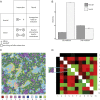Socially mediated induction and suppression of antibiosis during bacterial coexistence
- PMID: 26216986
- PMCID: PMC4568218
- DOI: 10.1073/pnas.1504076112
Socially mediated induction and suppression of antibiosis during bacterial coexistence
Abstract
Despite their importance for humans, there is little consensus on the function of antibiotics in nature for the bacteria that produce them. Classical explanations suggest that bacteria use antibiotics as weapons to kill or inhibit competitors, whereas a recent alternative hypothesis states that antibiotics are signals that coordinate cooperative social interactions between coexisting bacteria. Here we distinguish these hypotheses in the prolific antibiotic-producing genus Streptomyces and provide strong evidence that antibiotics are weapons whose expression is significantly influenced by social and competitive interactions between competing strains. We show that cells induce facultative responses to cues produced by competitors by (i) increasing their own antibiotic production, thereby decreasing costs associated with constitutive synthesis of these expensive products, and (ii) by suppressing antibiotic production in competitors, thereby reducing direct threats to themselves. These results thus show that although antibiotic production is profoundly social, it is emphatically not cooperative. Using computer simulations, we next show that these facultative strategies can facilitate the maintenance of biodiversity in a community context by converting lethal interactions between neighboring colonies to neutral interactions where neither strain excludes the other. Thus, just as bacteriocins can lead to increased diversity via rock-paper-scissors dynamics, so too can antibiotics via elicitation and suppression. Our results reveal that social interactions are crucial for understanding antibiosis and bacterial community dynamics, and highlight the potential of interbacterial interactions for novel drug discovery by eliciting pathways that mediate interference competition.
Keywords: Streptomyces; antibiotics; competition sensing; microbial ecology; sociomicrobiology.
Conflict of interest statement
The authors declare no conflict of interest.
Figures






Comment in
-
Antibiotics and the art of bacterial war.Proc Natl Acad Sci U S A. 2015 Sep 1;112(35):10827-8. doi: 10.1073/pnas.1513608112. Epub 2015 Aug 24. Proc Natl Acad Sci U S A. 2015. PMID: 26305963 Free PMC article. No abstract available.
References
Publication types
MeSH terms
Substances
Grants and funding
LinkOut - more resources
Full Text Sources
Other Literature Sources
Medical
Molecular Biology Databases

